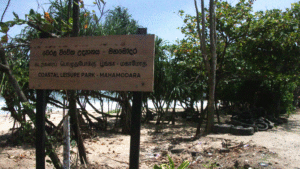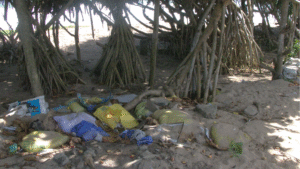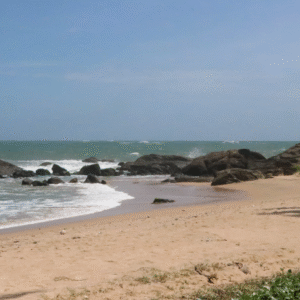16-year-old Hesandi investigates development plans for her local beach
October 17, 2025
Coast Conservation Dept cleans up Galle beach for new project

Several unauthorised restaurants at Mahamodara beach near Galle in southern Sri Lanka were torn down by the Coast Conservation Department (CCD) in July.
It was a relatively secluded beach, protected by a dense wall of trees that blocked access to it, with a few lemonade stands on the edge of the road. The CCD allowed the lemonade stands to continue their business as long as they didn’t cut down any of the trees or build permanent structures. This peaceful and fair agreement lasted for several years.
However, the area grew in popularity after the Covid-19 pandemic, when a supermarket was built just opposite the beach. Opportunists took this as a chance to build unauthorised, permanent structures such as restaurants and shops, which violated the CCD’s conditions.
Harbingers’ Weekly Brief
More and more trees started to disappear, while other crimes, such as pickpocketing, alleged drug distribution and the exploitation of protected turtle species, started to become more common. This is why the CCD had to intervene.
The CCD has since announced that it will develop a “coastal leisure park” on this section of the beach, including some permanent restaurants and shops – although exact details are not yet clear.
Turtle exploitation
Sri Lanka is home to five out of the seven sea turtle species in the world – the hawksbill, green, olive ridley, leatherback and loggerhead.
With its sandy beach and wide shoreline, Mahamodara was a safe haven for egg-laying turtles. During the egg-laying season (November to May), the beach was frequently visited by green and olive ridley turtles, according to the local sea turtle hatchery.
Although the olive ridley turtle is the most abundant species, it remains vulnerable, while the green turtle is endangered – making Mahamodara extremely important for their survival.
According to many locals, people would wait for turtles to lay their eggs on the shore before stealing a handful to eat and sell. They would leave only about 40 eggs, which would then be hatched and sold for 500–1,000 rupees ($2-4) each to tourists to release them back into the wild.
Not only are these endangered turtles hatched and sold without permission or a proper licence, but it is also estimated that only 1 in 1,000 hatchlings survive until adulthood, so it is safe to assume that sparing 40 eggs per batch will not help. Some of these eggs are sold to turtle hatcheries, where turtle exploitation is still promoted, although they may have a higher chance of survival.
The sea turtle hatchery is located next to Mahamodara beach. The farm takes in sick and injured turtles from the local Department of Wildlife Conservation and releases them once they are healthy. They often have all five turtle species under their care, with most of them staying for about three to four months.
The farm also rescues turtle eggs that would be otherwise eaten on the beach, before hatching and releasing them back into the sea.
It is not clear whether the proposed leisure park will improve conditions for the turtles or whether the increase in tourism will cause more problems.



Mahamodara beach is a nesting site for the green sea turtle. [Swipe right for more]
Picture by: Hesandi Sarasini Ravisinghe
A sign on Mahamodara beach for the new leisure park.
Picture by: Hesandi Sarasini Ravisinghe
Trash left on the beach by the unauthorised restaurants.
Picture by: Hesandi Sarasini Ravisinghe
The future of Mahamodara beach
Now that the unauthorised restaurants have been removed and the CCD has promised to build new restaurants and shops for the leisure park, a different future awaits Mahamodara beach.
Harbingers’ Magazine interviewed several restaurant and shop owners still remaining in the area to ask them what had happened and how they were affected. (Names have been changed for safety and privacy reasons.)
Chandrika has owned a lemonade stand at the beach for four years. “I couldn’t do business here when the CCD evacuated our shops,” she said.. “[The CCD] promised to build us new premises, so I hope that’s true.” Chandrika feels safer now that there are less crimes happening in the area.
Kamala, another lemonade stand owner, says, “I’ve owned this stand for 23 years now, and I’ve followed all the rules. Never in my life have I even thought of cutting down a single tree here!” Kamala feels that the unauthorised constructions on the beach ruined the lives of everyone, stating that “because of them, we might have to leave this place for good”.
She remembers when people would secretly buy and sell drugs in the restaurants, and nothing was done about it. “It was very scary,” she said, “you couldn’t even bring your family here.”
“The CCD has promised us new shops, but I like the way things were before – it’s a shame they had to cut down all these trees. After being here for 23 years, this place is very special to me.”
Anura has sold fruit on Mahamodara beach for the past six years. “This beach used to be so quiet, there was only one path to the water before they [the unauthorised restaurants] came here. Then the trees started disappearing too. It was tragic to watch,” he said.
“Some of the restaurants dealt in drugs, which is why the authorities cleared the area so fast. They’d also sell baby turtles so people can release them, which seems kind – until you find out that they eat the rest of the eggs.” He said that you couldn’t do anything about it because it was potentially dangerous.
Ranjani owned one of the unauthorised restaurants for about four years. “The CCD has promised us newer restaurants after they turn the beach into a leisure park, so I’m not too concerned,” she said. “Besides, I think this place looks so much better now, and you can see the beach from the road too!” Ranjani feels that the beach is a lot safer now that people cannot hide in the trees, reducing the risk of pickpocketing.
Written by:

Science Section Editor 2025
Galle, Sri Lanka
Born in 2009, Hesandi lives in Galle, Sri Lanka, and has a deep interest in art, nature, and wildlife, particularly elephants, leopards, and birds.
She joined Harbingers’ Magazine as a contributor to its Sri LankanNewsroom. After completing the Essential Journalism Course, she became a writer, continuing to cover wildlife and science topics. Her passion for journalism and dedication to her work led to her promotion as Science Section Editor in March 2025. She will also be editing articles from the NepaliNewsroom.
In her free time, Hesandi enjoys painting and has a passion for travel.
She speaks English and Sinhala and is currently learning Indonesian.
Edited by:

🌍 Join the World's Youngest Newsroom—Create a Free Account
Sign up to save your favourite articles, get personalised recommendations, and stay informed about stories that Gen Z worldwide actually care about. Plus, subscribe to our newsletter for the latest stories delivered straight to your inbox. 📲
© 2025 The Oxford School for the Future of Journalism



